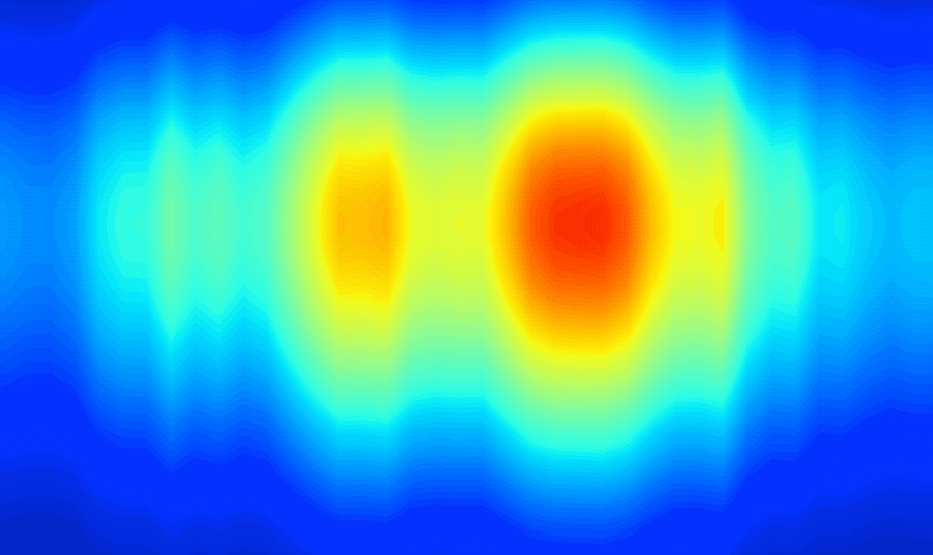Nasa's neutron star Interior Composition Explorer (NICER) has, for the first time, witnessed the integration of multimillion-degree X-Ray spots on the surface of a magnetar — a supermagnetized stellar core that is no larger than a city.
 This plot tracks 37 days of change in SGR 1830’s peak X-Ray emission as seen by NASA’s Neutron star Interior Composition Explorer (NICER). In this graph, the star’s rotational phase advances from left to right, with the measured energy shown vertically. The green, yellow, and red areas indicate regions producing the greatest numbers of X-Rays and are thought to represent the magnetar’s hot spots. They change in intensity and in their positions relative to each other as time goes on. For the first time, astronomers recorded two such spots merging. Image Credit: NASA/NICER/G. Younes et al., 2022.
This plot tracks 37 days of change in SGR 1830’s peak X-Ray emission as seen by NASA’s Neutron star Interior Composition Explorer (NICER). In this graph, the star’s rotational phase advances from left to right, with the measured energy shown vertically. The green, yellow, and red areas indicate regions producing the greatest numbers of X-Rays and are thought to represent the magnetar’s hot spots. They change in intensity and in their positions relative to each other as time goes on. For the first time, astronomers recorded two such spots merging. Image Credit: NASA/NICER/G. Younes et al., 2022.
NICER tracked how three bright, X-ray-emitting hot spots slowly wandered across the object’s surface while also decreasing in size, providing the best look yet at this phenomenon. The largest spot eventually coalesced with a smaller one, which is something we haven’t seen before.
George Younes, Researcher, George Washington University
Younes is also a researcher at NASA’s Goddard Space Flight Center in Greenbelt in Maryland.
This unique set of observations in the study headed by Younes will help researchers achieve a more complete understanding of the interplay between the crust and magnetic field of these extreme objects. The study was published on January 13th, 2022, in The Astrophysical Journal Letters.
A magnetar is a kind of isolated neutron star — the crushed core that is left behind during the explosion of a massive star. Compressing mass more than that of a Sun’s into a ball around 20 km (12 miles) across, a neutron star is composed of dense matter that a teaspoonful would be as heavy as a mountain on Earth,
Magnetars have the strongest magnetic fields known, which sums to a maximum of 10 trillion times more powerful than that of a refrigerator magnet and a thousand times sturdier than that of a typical neutron star. It is this power that sets them apart. The magnetic field characterizes a vast storehouse of energy that, when interrupted, can influence an outburst of improved X-Ray activity that can last from a few months up to a few years.
Such an outburst from a new magnetar, known as SGR 1830-0645 (SGR 1830 for short), was discovered by Neil Gehrels Swift Observatory of NASA, on October 10th, 2020. It is situated in the constellation Scutum.
Although its distance is not accurately identified, astronomers estimate that the object is located approximately 13,000 light-years away. Turning its X-Ray telescope to the source, Swift found repeated pulses that showed that the object was rotating for every 10.4 seconds.
Taken on the same day, NICER measurements reveal that the X-Ray emission showed three close peaks with every rotation. The peaks were caused when three individual surface regions even hotter than their surroundings spun into and out of our view.
Since its discovery on November 17th, NICER has witnessed SGR 1830 almost every day, after which the Sun was in close vicinity to the view field for safe observation. Over this duration, the emission peaks slowly shifted, occurring at different times in the magnetar’s rotation.
The findings favor a model where the spots occur and move as a consequence of crustal motion, in much the same way as the tectonic plates’ motion on Earth influence seismic activity.
The crust of a neutron star is immensely strong, but a magnetar's intense magnetic field can strain it beyond its limits. Understanding this process is a major challenge for theorists, and now NICER and SGR 1830 have brought us a much more direct look at how the crust behaves under extreme stress.
Sam Lander, Study Co-Author and Astrophysicist, University of East Anglia
The team believes these observations show a single active region where the crust has become partly molten, gradually deforming under magnetic stress. The three moving hot spots potentially characterize positions where coronal loops, which are identical to the shiny, radiant arcs of plasma observed on the Sun, connect to the surface. The drifting and merging behaviors are driven by the interplay between the loops and crustal motion.
Changes in pulse shape, including decreasing numbers of peaks, previously have been seen only in a few ‘snapshot’ observations widely separated in time, so there was no way to track their evolution. Such changes could have occurred suddenly, which would be more consistent with a lurching magnetic field than wandering hot spots.
Zaven Arzoumanian, Science Lead, Neutron star Interior Composition Explorer, Goddard Space Flight Center
NICER — an Astrophysics Mission of Opportunity within NASA’s Explorers Program — offers frequent flight opportunities for remarkable scientific investigations from space using streamlined, innovative and efficient management methodologies within the science fields of heliophysics and astrophysics.
Demonstrating pulsar-based spacecraft navigation, NASA’s Space Technology Mission Directorate backs the SEXTANT element of the mission.
NASA's NICER Tracks a Magnetar's Hot Spots
Explore how NASA’s Neutron star Interior Composition Explorer (NICER) tracked brilliant hot spots on the surface of an erupting magnetar — from 13,000 light-years away. Video Credits: NASA’s Goddard Space Flight Center.
Journal Reference:
Younes., G., et al. (2022) Pulse Peak Migration during the Outburst Decay of the Magnetar SGR 1830-0645: Crustal Motion and Magnetospheric Untwisting. The Astrophysical Journal Letters. doi.org/10.3847/2041-8213/ac4700.